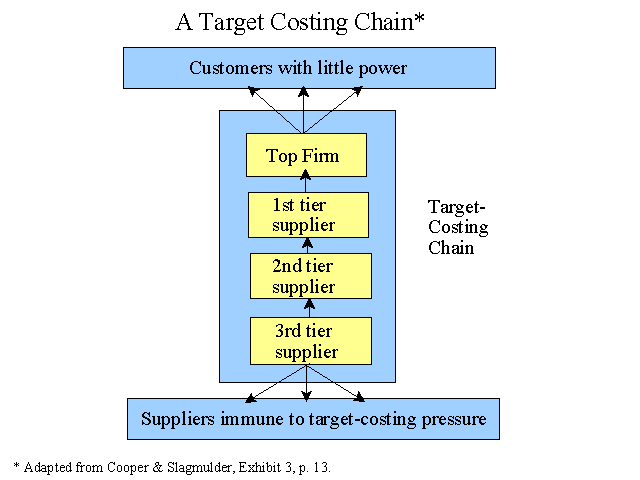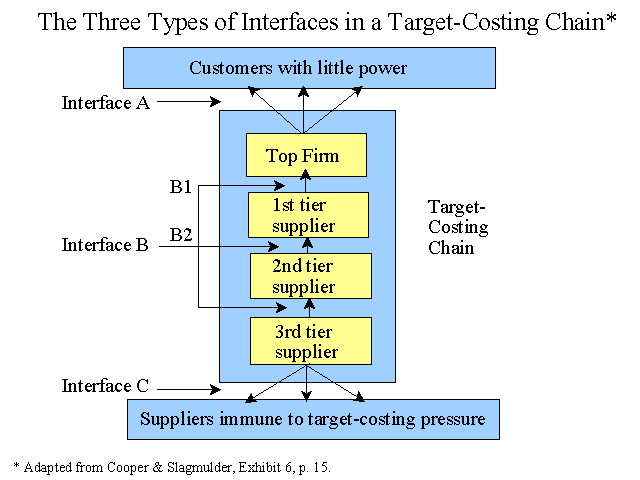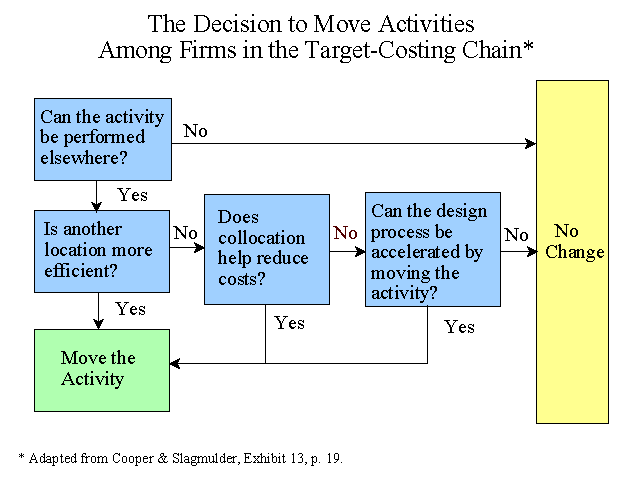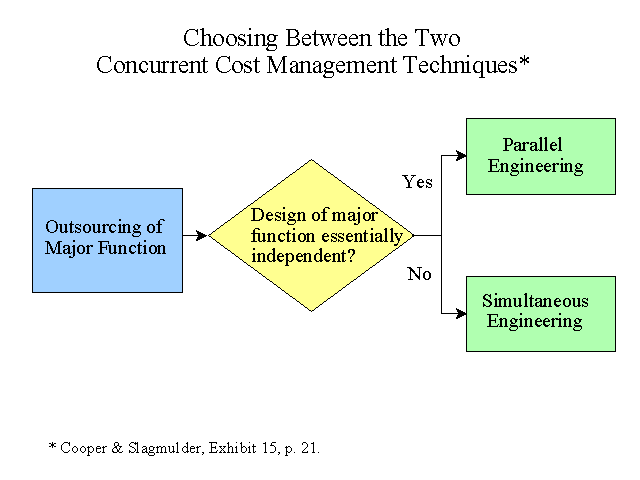
Summary by Kevin Elliott
Master of Accountancy Program
University of South Florida, Fall 2004
Target Costing Main Page | Continuous Improvement Main Page
This is the second in a two part sequence of articles dealing with the three major aspects of interorganizational cost management:
improved product design,
improved efficiency in the manufacturing processes, and
increased efficiency of the interface between buyers and sellers.
While improved product design was discussed in the first part of this series, part two focuses on the second and third aspects (p. 12). (See the first article for an overall view of the ICM process).
Coordinating the product development processes
This section of the article describes the hierarchy established by a system of target-costing. Each firm (or tier) in the group is linked to another by the output of a buyer’s target-costing system which becomes the input to a supplier’s target costing system. Each tier’s allowable costs become the basis for setting the product level costs and thereby setting the component-level costs for the supplier (p. 12). This situation allows each supplier to set the component-level price based on their costs of the component purchased from their suppler. The firm at the top of the chain benefits in this situation by being able to transmit the competitive pressure it faces down on its suppliers. The pressure transmitted is based on the top firm’s customer demand for quality and functionality. The firm on the end of the chain does not have the luxury of using target costing because its suppliers are in a more powerful position to set prices. This system becomes a valuable tool (for the top firm) in encouraging supplier firms to become more efficient. These relationships are illustrated in Exhibits 2 and 3 in the article. An adaptation of Exhibit 3 appears below.

These target costing chains typically range from two to six members with most having two to four firms. The chains can be described in one of three network setups. Each chain is either: (1) a kingdom, where there is only one end buyer, so the end buyer and the total supplier network are identical, (2) a barony, containing several end buyers, where the end buyer’s supplier network will form part of the overall supplier network, or (3) a republic, where the end-buyer’s network will form all or part of the overall network. Chained target-costing is most effective when the buyer and seller’s design teams can interact to change specifications in the design stage.
The buyer-supplier interface
The nature of the interface between the buyer and seller is based in large part on the placement of each in the target costing chain. There is very little power from the buyer’s end at the top of the chain (interface A), however in the middle the buyers can have considerable influence over suppliers (interface B), and at the end of the chain buyers can exercise considerable power over the firm but little power over suppliers (interface C). Therefore, those at the end are under high pressure to reduce costs with their on suppliers.

For firms at the top and in the middle of the target costing chain there can be significant cost reductions through interaction with suppliers. Again the firms stuck at the end of the chain have little no influence on supplier costs. The end firm must attempt to put pressure on its suppliers to reduce costs, with the help of the supplier’s other customers. Market-driven costing is most effective in the top and middle portions of the costing chain, having little effect at the end where the firm has little ability to control the selling price of its suppliers.
Functionality Price Quality (FPQ) Trade-offs
Market-driven costing for firms in the middle of the chain is very simple; their selling price is determined primarily by their buyer’s target costing systems. These prices are set by buyers and are rarely subject to change however, the functionality and quality of the products produced can be altered. Functionality, quality and price make up the “Survival Triplet” and the ability to manage it dictates the survival of firms in the middle of the chain. These reductions can only be successful if they do not reduce the quality and functionality of the end product (p. 16).
Interorganizational cost investigations
A target costing chain can be limited by a buyer designing a component that leads to manufacturing cost that are unnecessarily high. The problem occurs when the specifications set by the buyer cause the component to be unprofitable to the supplier, leaving the supplier with two choices. The supplier can either refuse to produce the component or negotiate a higher selling price (neither choice is advantageous to the supplier). However, the supplier may turn to a third option, an interorganizational cost investigation. An interorganizational cost investigation allows for more fundamental changes to be made than with a simple FPQ trade-off. This type of investigation involves the interaction of buyer and seller design teams as well as value-engineering techniques. The greatest value is the increased scope of the design changes that can be implemented to the end product and the component it contains.
Interorganizational cost investigation can reduce costs in two ways:
The location where activities are performed can be changed so they are performed
more efficiently.
The need to perform activities can be reduced or avoided by redesigning the
product and the components it contains to take full advantage of
manufacturing skills throughout the target-costing chain.

Concurrent cost management
Although interorganizational cost investigation and chained target costing allows for a broader scope of changes to be made to an end-product and its components these two techniques still limit the extent of the influence a buyer can exhort. The limitation occurs because of how late in the development process these techniques are often implemented. This limitation can be avoided by early supplier involvement in the design process.
When a buyer allows the research and development to be outsourced for a major function or group component, then concurrent cost management becomes a powerful tool (p. 20). Concurrent cost management has two major approaches, parallel and simultaneous engineering. In parallel engineering the specifications are supplied by the supplier, in contrast to simultaneous engineering, where the buyer’s and supplier’s design teams work together. The choice between each is based on the benefit that interaction between the two groups would produce. Both approaches fundamentally change supplier relations because the supplier is not asked to design a major function or group component rather than just an individual component. By outsourcing the R&D function the buyer has now become dependent on the supplier for technical support and the buyer represents a large majority of the supplier’s business.

Both parallel and simultaneous engineering provide the same benefits and have the same flaw (p. 21):
Benefits:
Gives suppliers more time to design their products, and hence more opportunity to reduce costs.
Enables suppliers to develop new generations of their products independent of product design process of their customers.
Allows faster introduction of products because the product development processes of the buyer and supplier are occurring at the same time.
Reduces overall costs by allowing the supplier to spread costs over the products of all customers.
Flaw: Buyers lose much of their ability to differentiate products based on any proprietary technology used in the major function.
Coordinating manufacturing activities
Kaizen costing is the primary technique used to coordinate manufacturing activities in a supplier network. The process begins when a buyer transmits cost reduction pressure that it faces in the market-place by informing suppliers that the selling price is expected to fall over time. Kaizen cost reduction objectives differ from traditional target costing component-specific objectives set by the buyer. The difference reflects the basic differences between target and kaizen costing. First, savings achieved from target costing are greater than savings from kaizen costing. Second, cost-reduction opportunities that were not recognized during the design stage will never be realized because once designed the components costs become fixed. With this in mind it becomes less critical to achieve savings in a given year since smaller costs savings can be achieved over multiple periods (p. 22).
Initiating interorganizational kaizen costing
Initiating interorganizational kaizen costing relies heavily on having a strong relationship with suppliers. Interorganizational kaizen costing can be initiated by either the buyer or the supplier. Each side must understand the mutual benefit achieved by investing in the other. A balance of power must exist to ensure each side benefits equally from the savings.
Buyer-led initiatives take two fundamental approaches to reducing costs. First, educating suppliers and second giving them access to cost savings they cannot achieve in isolation. The first approach most often leads to redesigning a part to make it more compatible with a supplier’s production system. The second method, allowing access to cost savings, is archived through two methods. One method is to identify a less expensive source for items used by the supplier (single-supplier approach) and another is to take advantage of the buying power of the firm and its suppliers to buy in volume at a lower rate (multiple-supplier approach). In each case the savings are passed on to the buyer.
In supplier led initiatives, suppliers identify new ways to design so it has a lower cost, holding quality constant. Only through buyer interaction can this be classified as an interorganizational kaizen costing method. Buyer involvement usually is achieved in one of three ways:
Buyer changing its product in some way to accommodate the new low-cost component
Buyer agrees to change its production processes to accommodate changes in design of the component
Buyer provides the supplier with engineering support to help identify and approve changes in the design of the component or its production process
Conclusion
The three major aspects of interorganizational cost management discussed in this paper are complimentary and can be used to reduce costs across the supply chain. This can be achieved by the three major enabling mechanisms that help the firms in the target-costing chain achieve their cost reduction objectives. Interorganizational cost investigations are a result of these mechanisms failing to achieve target costs for one of the products. These investigations however are too late to affect the inefficiencies that have occurred during the design of the component, clearly defining a need for outsider help early on. Outsourcing the R&D function by involving suppliers in the design process is one way to maximize efficiency of operations. Finally implementing kaizen cost-reduction objectives will continually reduce costs through continuous and gradual improvement of the target-costing chain.
For Part 1 see Cooper, R. and R. Slagmulder. 2003. Interorganizational costing, Part 1. Cost Management (September/October): 14-21. (Summary).
________________________________________________
Related summaries:
Clinton, B. D. and S. C. Del Vecchio. 2002. Cosourcing in manufacturing. Journal of Cost Management (September/October): 5-12. (Summary).
Clinton, B. D. and S. C. Del Vecchio. 2002. Cosourcing in manufacturing - Just in time. Journal of Cost Management (November/December): 30-37. (Summary).
Dummer, W., M. Masters and D. Swenson. 2015. Delivering customer value through value analysis. Cost Management (March/April): 17-24. (Summary).
Martin, J. R. Not dated. Lean concepts and terms. Management And Accounting Web. LeanConceptsandTermsSummary.htm
Martin, J. R. Not dated. Profit Beyond Measure graphics and notes. Management And Accounting Web. JohnsonBromsGraphicsNotes.htm
Martin, J. R. Not dated. Supply chain arrangements. Management And Accounting Web. SupplierArrangementsSummary.htm
Martin, J. R. Not dated. What is lean accounting? Management And Accounting Web. LeanAccounting.htm
Sakurai, M. 1989. Target costing and how to use it. Journal of Cost Management (Summer): 39-50. (Summary).
Schmelze, G., R. Geier and T. E. Buttross. 1996. Target costing at ITT Automotive. Management Accounting (December): 26-30. (Summary).
Tanaka, T. 1993. Target costing at Toyota. Journal of Cost Management (Spring): 4-11. (Summary).
Yu-Lee, R. T. 2002. Target costing: What you see is not what you get. Journal of Cost Management (July/August): 23-28. (Summary).